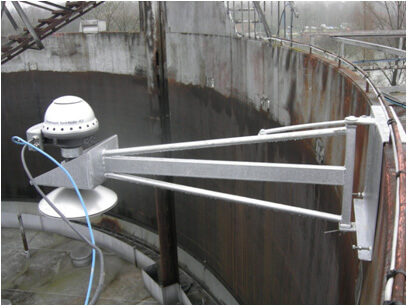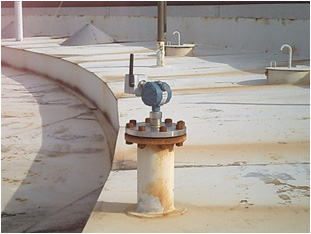Happy New Year everyone!
Our new year here at the Emerson Process Experts blog got off to a rocky start with a database crash late yesterday. We seem to have things restored and will be spot checking everything, but leave a comment if you encounter anything out of the ordinary. Enough with the tale of woe, on with the blogging!
I found a 2003 Hydrocarbon Processing article, Floating-roof technology advances with lessons learned from an 80-year history, that floating roofs on storage tanks have been with us since 1923. A Wikipedia entry, External floating roof tank describes the advantages and disadvantages of this design.
Advantages:
External roof tanks are usually installed for environmental or economical reasons to limit product loss and reduce the emission of volatile organic compounds (VOC), an air pollutant.
Normally (roof not landed), there is little vapor space, and consequently a much smaller risk of internal tank explosion.
Disadvantages:
Rain water and snow can accumulate on the roof, eventually the roof may sink.
Water on the roof is usually drained from a flexible hose that runs from a drain-sump on the roof, through the stored liquid to a drain valve on the shell at the base of the tank. The hose often develops leaks and drains both water and product.
I share this as background to an Emerson Exchange conference – Anaheim presentation, Is your Floating Roof really floating?, by Emerson’s Mikael Helmer.
If the roof starts sinking or gets stuck, the tank farm enters a dangerous state, which poses a major safety risk and potentially significant consequences including:
- Hydrocarbon vapor releases
- Fires and explosions due to volatile product exposed
- Large mechanical damages
- Financial damages
- Environmental damages
- Loss of life
Problems can arise from:
- Leaking pontoons or punctured deck
- Increasing rim seal friction—dual and triple seal becoming increasingly popular to minimize vapor emissions
- Tank Wall abnormalities preventing the roof from floating freely
- Roof access rolling ladder not moving freely
Traditionally, visual inspections have been performed by climbing the tanks. This approach requires frequent trips to the tank, especially around significant weather events. This process requires plant operations staff to enter the roof to open and inspect the pontoons through several inspection hatches. The goal is to minimize time in this hazardous environment.
Technology has come along to help. Cameras are being used for remote visual inspection. Even better, by installing level instruments at multiple points, provides immediate feedback and alarm conditions to the operators and maintenance team. These level instruments measure the distance to the roof as well as provide a comparison between the primary level gauge and the roof measurements.
 Where instrumentation cabling is already available out at the tank, wired radar gauges mounted 120 degrees apart can be installed on the tank measuring down onto the floating roof. Having the level measured at 3 spots provides a comparison on how the roof is floating and helps spot tilt conditions. These level instruments can also be used as part of an overfill prevention system.
Where instrumentation cabling is already available out at the tank, wired radar gauges mounted 120 degrees apart can be installed on the tank measuring down onto the floating roof. Having the level measured at 3 spots provides a comparison on how the roof is floating and helps spot tilt conditions. These level instruments can also be used as part of an overfill prevention system.
 With the availability of guided wave radar devices with IEC 62591 wireless communications, instrumentation wiring at the tank is not required. Additionally, the guided wave radar transmitters can be mounted directly on the floating roof and communicate back to the operators via the wireless network.
With the availability of guided wave radar devices with IEC 62591 wireless communications, instrumentation wiring at the tank is not required. Additionally, the guided wave radar transmitters can be mounted directly on the floating roof and communicate back to the operators via the wireless network.
Like other applications such as rotating kilns and moving railcars, wireless devices open up the opportunity to be mounted on moving equipment, which is not practical for wired devices.
WirelessHART guided wave radar transmitters with single rigid probes are deployed at three nozzles on the floating roof. Each device continuously measures how deep the roof floats. Comparison between the three measurements provides input on how the roof floats and helps spot tilt or other problems.
These roof-mount radar probes are in addition to the primary radar level gauge, which measures liquid level for inventory purposes. This measurement also provides another point of comparison for the roof-mounted transmitters.
Whether wired or wireless, having continuous measurements provides real-time tracking of roof position and enables early warnings if something starts to change with the roof conditions. It also minimizes the need for maintenance personnel to enter the tank and tank roof hazardous areas. With this continuous monitoring, the frequency of visual inspections can be significantly reduced—perhaps even once per week.
Real-time monitoring in conjunction with an integrated terminal management and automation system can also eliminate visual inspections and tie into emergency shutdown systems (ESD) in order to alert personnel of potential problems before they result in dangerous conditions.
It’s great to see the advancement of technology in the 89 years these floating roofs have been with us!
| iTunes
